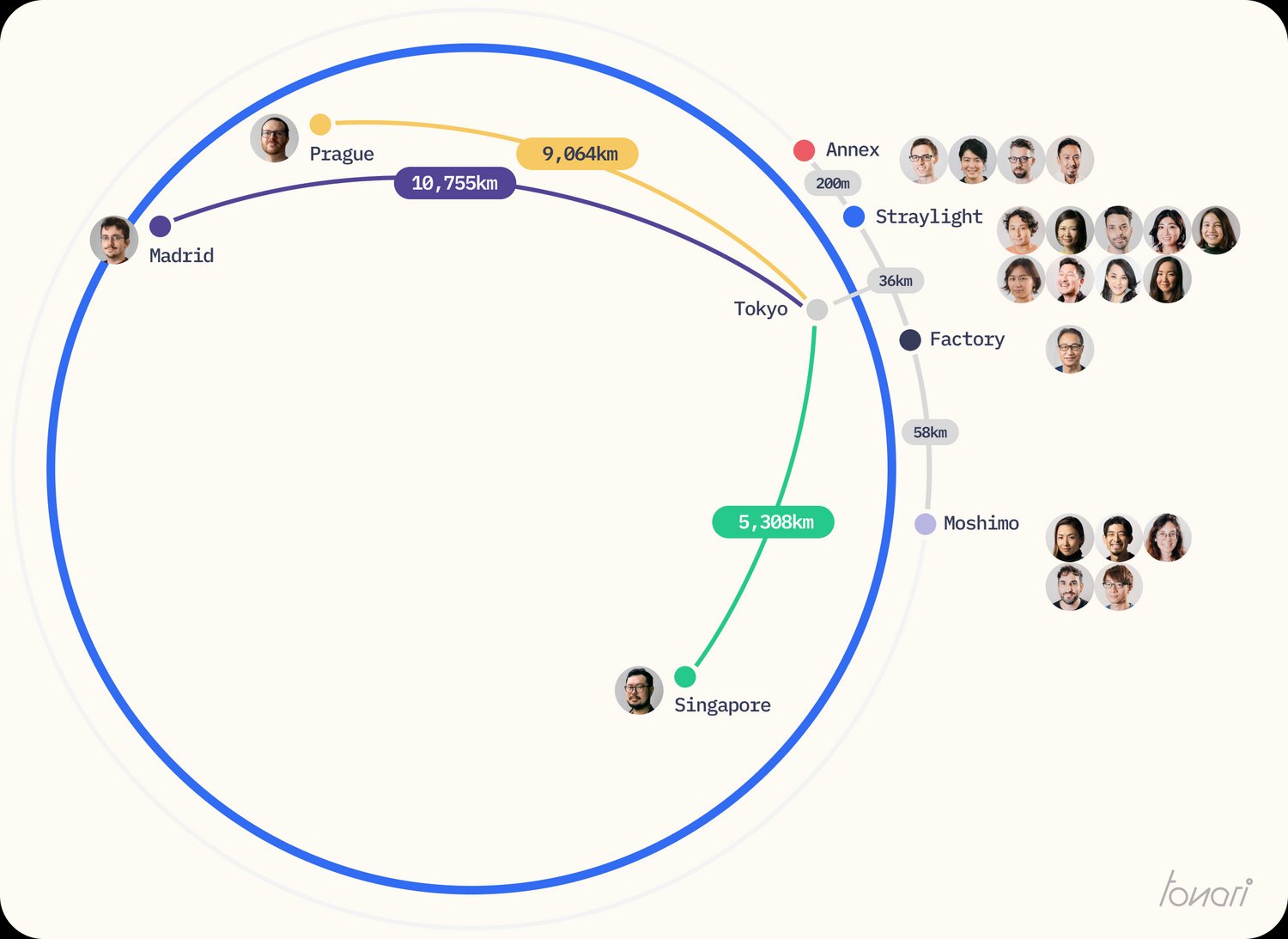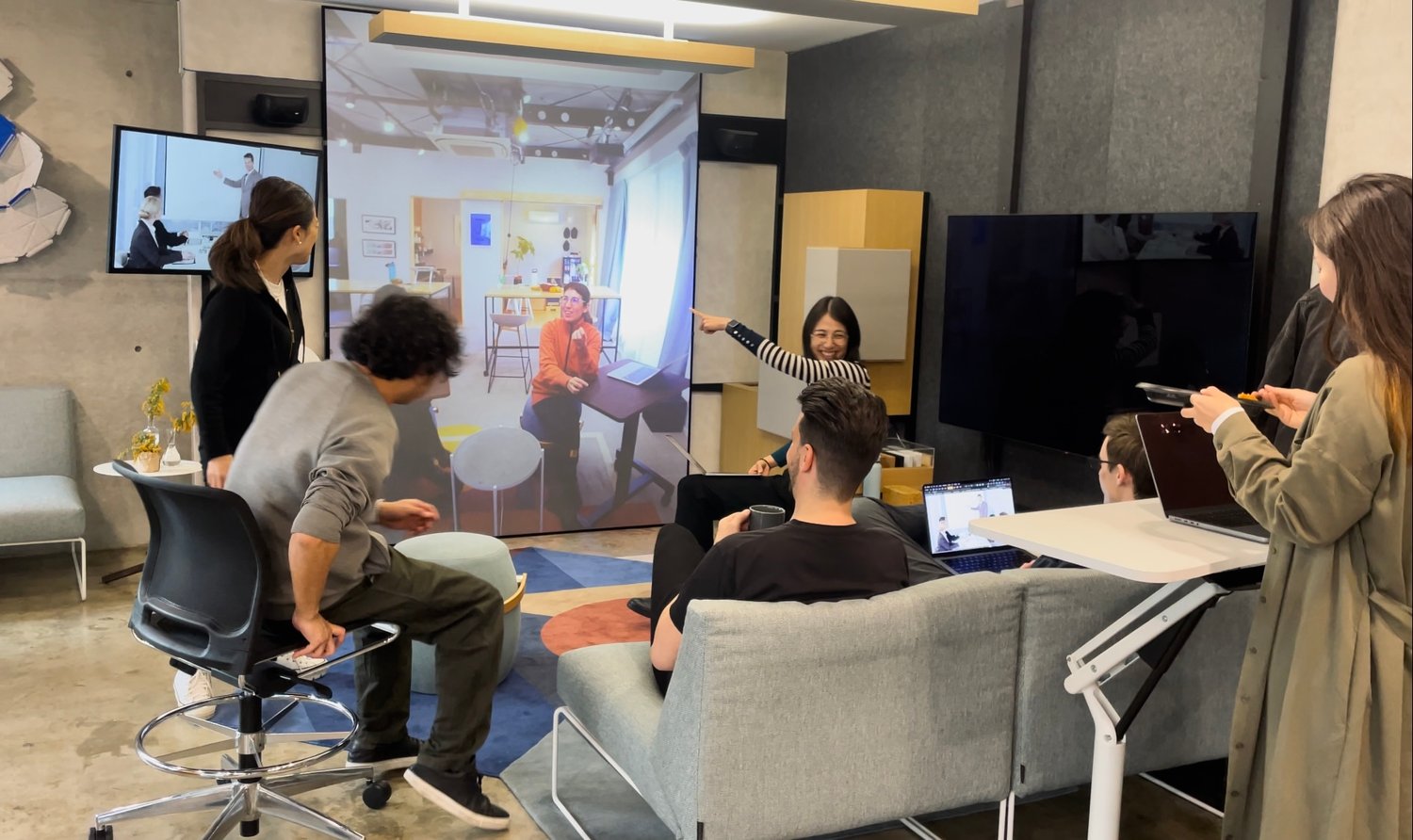tonari has grown — in fact, doubled — from a team of 11 to 22 in the last two years and is now present in seven locations around the world. Using a combination of remote and hybrid working styles, we’ve become a “crossover company” and created a futuristic yet practical setup where teams distributed around the world can work naturally together.
What we achieved
- Enabled our teams in Europe to have time and space to spend face-to-face with teams in Tokyo, and expand opportunities for genuine human connection
- Flexible and practical workplaces tailored to the lifestyles and home environments of team members living in Japan and abroad
- New possibilities for collaboration across distances, to provide more flexibility in the way we work
Collaboration across distances

The tonari team works across seven locations, four of which are connected via tonari: our Tokyo headquarters at Straylight, the Annex down the street for R&D, a studio in Prague, and the Moshimo space in Hayama. tonari is central to how the teams communicate across these distant spaces, allowing them to feel always connected despite physically being in different locations.
There’s a very common plot in Japanese TV dramas where characters sadly leave their Tokyo life because they ‘have to return to their hometowns.’ But now with tonari, Pablo and Matěj could even go back to their home countries and the team operates almost like nothing changed. Shiro Gono, Finance & Administration
Flexible work and life styles
Though the engineering team is split across the globe, they’re still able to spend most evenings in Japan and mornings in Europe together — to casually check in, collaborate on projects, and discuss new challenges. tonari connects Matěj (our engineer in the Prague Studio) to the Annex, where Pablo (our engineer who sits in Madrid) also connects to through a small experimental version of tonari. People in remote offices normally have to set specific times for one-on-one catch-ups, but our designer Adam likes the fact that he can talk to Matěj through tonari in a more casual way.
Visiting the Annex and talking to Matěj (in Prague) and Pablo (in Madrid) like we were all in the same room just blew my mind! It’s like something from science fiction, except it’s already a natural part of our everyday life! Megumi Koyama, Customer Success
In Japan, long commute times result in most working mothers only spending two hours a day with their children, but tonari helped solve this problem for Alisaun and Aoi. They lead sales from Hayama and often use tonari to have quick catch ups and discussions with others who work in marketing, PR, and customer success. Aoi says, “My kids are growing so fast every day, and tonari provides a way for me to make a lot of impact at work without missing out on my children’s lives.”
I had a second child because of tonari! Moshimo is less than five minutes’ walk from my home in Hayama, and the tonari there keeps me connected to our Straylight space in Tokyo. That connection gave me the confidence that I’d be able to keep contributing to the company, even while living in beachside Hayama and taking care of two small children. Alisaun Fukugaki, Partnerships
Experiencing genuine human connection
Unlike standard video chat, tonari is full-sized and always-on, which allows more genuine, natural experiences. By opening a life-sized portal into another space, teams on both sides can feel like they’re in the same space. One of the best things about tonari remains the serendipitous interactions that it makes possible. We’re always chatting and laughing with each other across the screen, and we easily celebrate things like small wins and birthdays together — like this impromptu cake party for Megu!
It’s hard to overstate how important latency, frame rate, or audio quality are in terms of feeling in close contact with the team, compared to something with less fidelity and more lag like a Zoom call. Pablo Mansanet, Engineer
Crossover spaces designed for a crossover company
What’s next?
tonari as a product has already strongly influenced the ways we collaborate and has allowed us to be more flexible in choosing the places we live — but there is still a lot to do! R&D at the Annex is currently focused on building out new form factors to make tonari work within more kinds of spaces. We’re also working to improve audio quality, which can be difficult to maintain at high fidelity in open spaces. But overall we’re pleased that tonari delivers natural, collaborative, and flexible working styles, and more importantly, it’s a technology that helps protect and promote our values.
We want to foster a work culture that is both adaptable and innovative, leveraging our own technology. By being able to work ‘face-to-face’ in the space collaborating daily, our team develops a strong sense of camaraderie, resulting in high levels of job satisfaction. Having colleagues in close proximity is pivotal for me when making strategic decisions, forging trust, and overcoming obstacles, ultimately boosting my motivation. Taj Campbell, Co-Founder
About tonari
tonari was founded in 2018 by former Google product manager Taj Campbell and engineer Ryo Kawaguchi. The developed tonari, which connects two spaces via a life-size screen and aims to create a world without boundaries caused by physical distance.
See our blog posts on how tonari uses tonari here👉:2021 - How tonari uses tonari, 2023 - How tonari shapes our team

